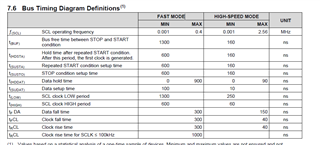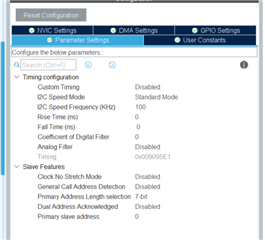Other Parts Discussed in Thread: INA226, SYSCONFIG
Tool/software:
Hello we are using the TI INA219 with a STM H7 Nucleo reference board over I2C. Questions:
1. Are there any sample device drivers from TI for using TI's INA219 over I2C?
2. Would TI recommend an I2C speed mode of at least 400 KHz (fast mode) or would standard mode I2C (100 KHz) work? We saw in the datasheer support for fast and high speed mode, but it appearded the min on fast mode range is standard mode 100KHz?
3. Should the I2C bus be configured with an analog filter enabled or disabled?
4. Is there a coefficient of digital filter value that the I2C bus master should use to communicate with the INA219?
4. On pg 6 of the datasheet below on bus timing it shows clock fall time and rise time, as well as a data fall time, etc.

Does this require the I2C bus on which the INA219 resides master be configured for the shown rise and fall times specifically for the INA219 i.e., like shown below?

Thank you again,
Tammy

